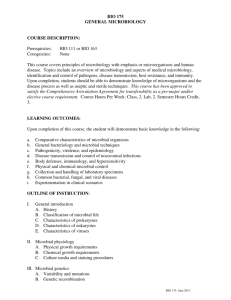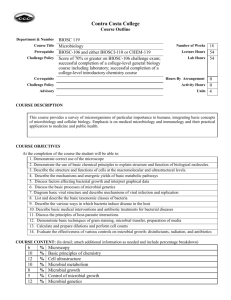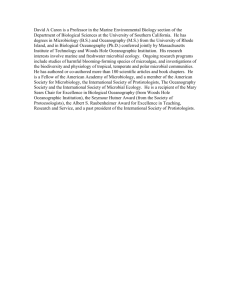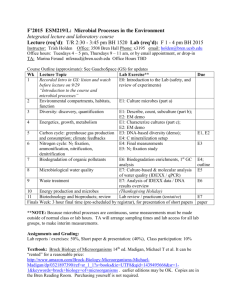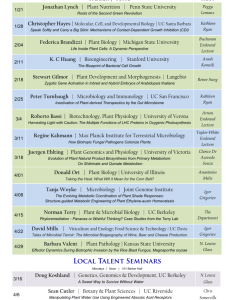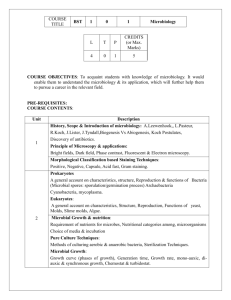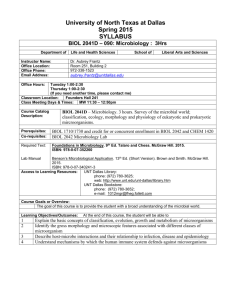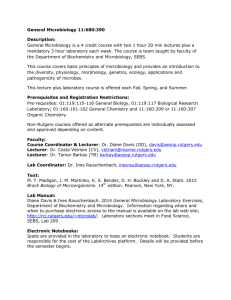BIO 211 - Salem Community College
advertisement
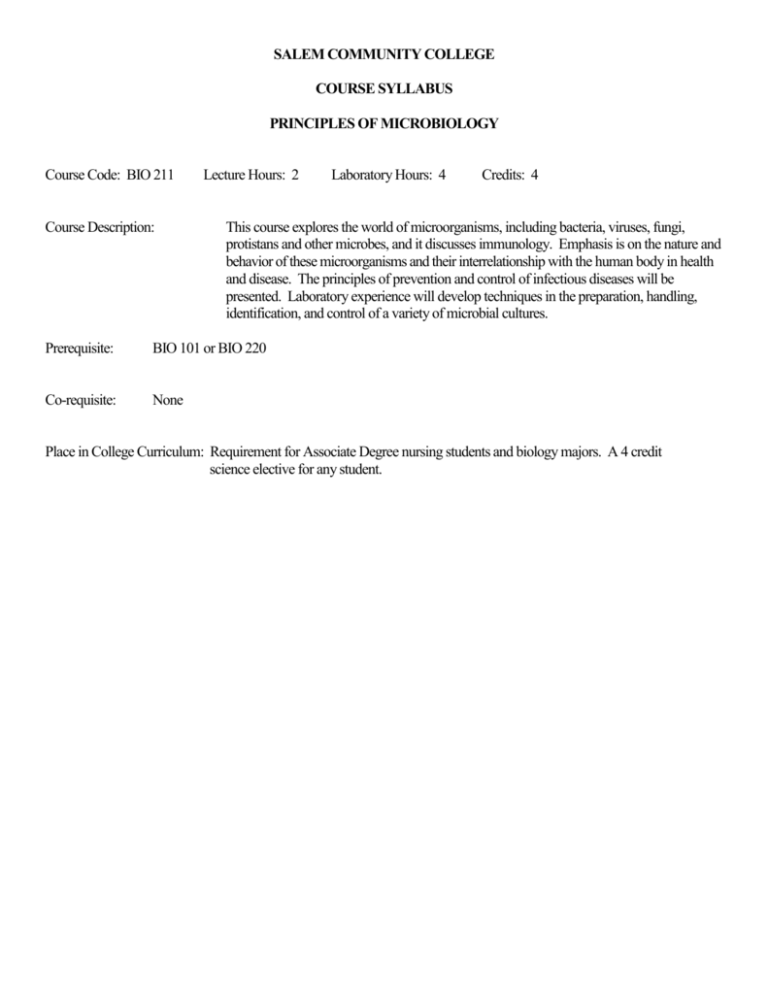
SALEM COMMUNITY COLLEGE COURSE SYLLABUS PRINCIPLES OF MICROBIOLOGY Course Code: BIO 211 Course Description: Lecture Hours: 2 Laboratory Hours: 4 Credits: 4 This course explores the world of microorganisms, including bacteria, viruses, fungi, protistans and other microbes, and it discusses immunology. Emphasis is on the nature and behavior of these microorganisms and their interrelationship with the human body in health and disease. The principles of prevention and control of infectious diseases will be presented. Laboratory experience will develop techniques in the preparation, handling, identification, and control of a variety of microbial cultures. Prerequisite: BIO 101 or BIO 220 Co-requisite: None Place in College Curriculum: Requirement for Associate Degree nursing students and biology majors. A 4 credit science elective for any student. Principles of Microbiology / Page 2 Major Units Unit I. Fundamentals of Microbiology Unit II. Survey of Microbial World Unit III. Interactions Between Microbe and Host Unit IV. Microbes and Human Disease Course Content by Units: Unit I. Fundamentals of Microbiology A. The Microbial World and You B. Observing Microbes through the Microscope C. Anatomy of Procaryotes and Eucaryotes D. Microbial Metabolism E. Microbial Growth F. Control of Microbial Growth G. Microbial Genetics Unit II. Survey of Microbial World A. Classification B. Bacteria C. Fungi, Algae, Protozoans and Other Parasites D. Viruses Unit III. Interaction Between Microorganism and Host A. Principles of Disease and Epidemiology B. Mechanisms of Pathogenicity C. Nonspecific Defense Mechanisms D. The Immune Response E. Applied Immunology F. Immune System Disorders G. Antimicrobial Drugs Unit IV. Microbes and Human Disease A. Microbial Diseases of the Skin and Eyes B. Microbial Diseases of the Nervous System C. Microbial Diseases of the Cardiovascular System D. Microbial Diseases of the Respiratory System E. Microbial Diseases of the Digestive System F. Microbial Diseases of the Urogenital System Principles of Microbiology / Page 3 Course Objectives by Unit: Unit I.Fundamentals of Microbiology Course Performance Objective #1: Describe the role of microorganisms in nature; including their unique structure, metabolic processes, growth characteristics, treatments devised against them, and their inheritance patterns. A. The Microbial World and You (Chapter 1) Enabling Objectives: 1. Identify the microbiological contributions of: Van Leeuwenhoek, Hooke, Pasteur, Koch, Lister, Ehrlich, Fleming and Jenner 2. List major groups of organisms studied in microbiology B. Microscopic Observation (Chapter 3) Enabling Objectives: 1. Identify parts of the microscope 2. Explain how the EM works 3. Compare simple, differential and special stains 4. Describe Gram staining procedures C. Anatomy of Prokaryotic and Eukaryotic Cells (Chapter 4) Enabling Objectives: 1. Identify the 3 basic bacterial shapes and the bacterial cell arrangements 2. Differentiate cell walls of Prokaryotes and Eukaryotes 3. Define simple diffusion, osmosis, facilitated diffusion, and active transport 4. Describe structures external and internal to the cell wall/membrane D. Microbial Metabolism (Chapter 5) Enabling Objectives: 1. Define metabolism; differentiate between anabolism and catabolism 2. Describe enzymatic activity 3. Explain the kinds of phosphorylation reactions 4. Explain glycolysis 5. Explain Krebs's cycle and the electron transport chain 6. Categorize the various nutritional patterns among microorganisms 7. List 4 biosynthetic pathways of energy utilization Principles of Microbiology / Page 4 E. Microbial Growth (Chapter 6) Enabling Objectives: 1. Define binary fission 2. List chemical and physical requirements for growth 3. Justify the use of: -selective and differential media -anaerobic techniques -living host cells 4. Describe the streak plate technique 5. Compare microbial growth phases and their relationship to generation time 6. Describe several direct and indirect measurements of microbial growth F. Control of Microbial Growth (Chapter 7) Enabling Objectives: 1. Define sterilization, disinfection, antisepsis, germicide, bacteriostasis, asepsis, & sanitization 2. Describe the physical and chemical methods of microbial control G. Microbial Genetics (Chapter 8) Enabling Objectives: 1. Describe how DNA serves as genetic information 2. Describe DNA replication 3. Define genetics, chromosomes, gene, genetic code, genotype, phenotype, mutagen and genetic recombination 4. Explain the regulation of gene expression in bacteria by induction, repression and attenuation 5. Classify the types of mutations 6. Compare and contrast transformation, transduction, and conjugation 7. Describe the function of transposons and plasmids Principles of Microbiology / Page 5 Unit II. A Survey of the Microbial World Course Performance Objective #2: Distinguish among the various roles in nature and characteristics of each of the following microorganisms: bacteria, fungi, algae, protozoans, viruses, and other human parasites. A. Classification of Microorganisms (Chapter 10) Enabling Objectives: 1. Define taxonomy and binomial nomenclature 2. List and characterize the five kingdoms 3. Review Bergey's Manual 4. Describe several methods of classification and identification of microbes B. Bacteria (Chapter 11) Enabling Objectives: 1. List several characteristics used to classify and identify bacteria 2. Name major bacterial groups and their characteristics C. Fungi, Algae, Protozoans, and Parasites (Chapter 12) Enabling Objectives: 1. Differentiate between asexual and sexual reproduction 2. Characterize the Fungi as to their vegetative and reproductive structures and nutritional adaptations 3. Describe characteristics and give examples of members of the medically important phyla of fungi 4. Describe the roles of algae in nature 5. List the medically important protozoan phyla and give their differential characteristics 6. List the groups of parasitic helminths and give their differential characteristics 7. Define intermediate and definitive host and vector D. Viruses (Chapter 13) Enabling Objectives: 1. Describe the composition of a typical virus 2. List criteria used to classify viruses 3. Explain how viruses are cultured 4. Describe the lytic cycle of T-even bacteriophages 5. Compare and contrast the multiplication cycle of DNA and RNA animal viruses 6. Differentiate between slow and latent viral infections 7. List the effects (CPE) of animal virus infection on host cells 8. Explain what a tumor is. Differentiate between malignant and benign tumors Principles of Microbiology / Page 6 Unit III. Interaction between Microbe and Host Course Performance Objective #3: Describe the potential interactions between microorganisms and their hosts; including possible diseases, mechanisms of pathogenicity, specific and nonspecific host defenses and disorders associated with these responses, as well as drug treatments that target certain microorganisms. A. Principles of Disease and Epidemiology (Chapter 14) Enabling Objectives: 1. Define normal flora 2. Compare commensalism, mutualism & parasitism and give examples of each 3. List Koch's postulates 4. Define a reservoir of infection 5. Define nosocomial infections 6. Explain methods of disease transmission 7. Define epidemiology 8. Differentiate between communicable and noncommunicable disease 9. Identify predisposing factors for disease 10. Define pathogen, etiology, infection, host, disease, acute, chronic, subacute and latent phases of disease 11. Differentiate between morbidity and mortality 12. Describe the typical pattern of a disease B. Mechanism of Pathogenicity (Chapter 15) Enabling Objectives: 1. Define and list portals of entry and exit. Give examples of organisms that enter and leave the human body by these routes. 2. Define pathogenicity, virulence and LD50 3. Explain how adherence, capsules, cell wall components, and enzymes contribute to pathogenicity 4. Compare the effects of hemolysins, leukocidins coagulase, kinases, hyaluronidase, and collagenases 5. Contrast the nature and effects of exotoxins and endotoxins 6. Outline the mechanisms of action of diphtherotoxin, botulism toxin, and tetanus toxin 7. Review CPE of viruses 8. Discuss the causes of symptoms in fungal infections. Principles of Microbiology / Page 7 C. Nonspecific Host Defenses (Chapter 16) Enabling Objectives: 1. Define resistance and susceptibility 2. Define nonspecific resistance 3. Describe mechanical and chemical factors of the skin and mucous membranes 4. Define phagocytosis, classify phagocytic cells and describe the roles of WBC in the phagocytic process 5. Define and describe the stages of inflammation 6. Define and describe the roles of fever, interferon and complement in nonspecific host defense D. Specific Host Defenses: The Immune System (Chapter 17) Enabling Objectives: 1. Contrast the types of acquired immunity 2. Define immunity, antigen, anamnestic response, lumphokines, and monoclonal antibodies 3. Discuss antibodies -structure and chemical characteristics -five classes of Ig's and their functions 4. Compare and contrast humoral and cell mediated immunity 5. Differentiate among the types of T-cells E. Disorders Associated with the Immune System (Chapter 19) Enabling Objectives: 1. Define the types of hypersensitivity reactions 2. Describe anaphylaxis and contact dermatitis 3. Define hypersensitivity, histocompatibility, antigens, desensitization, HLA, and immunologic tolerance 4. Discuss the human blood groups and transfusions 5. Explain transplant rejection 6. Discuss the major immune deficiencies 7. Describe the origin of AIDS, its effect on the immune system, mode of transmission, stages and treatments F. Antimicrobial Drugs (Chapter 20) Enabling Objectives: 1. Define chemotherapeutic agent, distinguish between a synthetic drug and an antibiotic 2. List 5 mechanisms of action of antimicrobial agents 3. Explain the mechanisms of action of antiviral drugs 4. Explain the mechanisms of action of antifungal drugs 5. Explain the mechanism of action of antiprotozoan drugs 6. Describe tests for microbial susceptibility to chemotherapeutic agents 7. Describe mechanisms of drug resistance Principles of Microbiology / Page 8 Unit IV. Microorganisms and Human Disease Course Performance Objective #4: Describe the cause and effect of microbial diseases involving the skin, eyes, nervous system, cardiovascular system, respiratory system, digestive system, and genitourinary system. A. Microbial Diseases of the Skin and Eyes (Chapter 21) Enabling Objectives: 1. Describe skin structure and susceptibility to pathogen invasion 2. List normal skin flora 3. List skin infections caused by staph and strep 4. List agent, transmission mode, and symptoms of acne, warts, smallpox, chickenpox, measles, rubella, cold sores B. Microbial Diseases of the Nervous System (Chapter 22) Enabling Objectives: 1. Briefly describe the anatomy of the brain and spinal cord 2. Know the causative agents of: meningitis, cryptococcosis, listeriosis, tetanus, botulism, poliomyelitis, rabies, encephalitis, leprosy, trypanosomiasis and slow viral diseases C. Microbial Diseases of the Cardiovascular System (Chapter 23) Enabling Objectives: Briefly discuss the anatomy & physiology of the cardiovascular system Identify the causative agents of puerperal sepsis, bacterial endocarditis, myocarditis, Burkett's lymphoma, rheumatic fever, infectious mononucleosis, tularemia, brucellosis, anthrax, gas gangrene, plague, relapsing fever, Lyme disease, typhus, yellow fever, dengue, toxoplasmosis, chagas disease, malaria and schistosomiasis D. Microbial Diseases of the Respiratory System (Chapter 24) Enabling Objectives: 1. Briefly describe the structure and function of the respiratory system 2. Identify how infections of the respiratory system are transmitted 3. Review the normal flora of the upper and lower respiratory systems 4. List the causative agents of the following: pharyngitis, scarlet fever, diphtheria, otitis media, common cold, pertussis, TB, sinusitis, pneumonia, psittacosis, Q fever, influenza, Legionellosis, histoplasmosis, coccidioidomycosis, blastomycosis and aspergillosis Principles of Microbiology / Page 9 E. Microbial Diseases of the Digestive System (Chapter 25) Enabling Objectives: 1. Briefly discuss the structure and function of the digestive system 2. Describe the antimicrobial features of the GI tract 3. Discuss microbes that cause dental carries and periodontal disease 4. List the causative agent symptoms and suspect foods of -staphylococcus enterotoxicosis -salmonellosis -typhoid fever -bacillary dysentery (shigellosis) -cholera -gastroenteritis 5. List the etiologic agents of gastritis, mumps, CMV inclusion disease, hepatitis (A,B,C,D,& E), giardiasis, balantidiasis, ameobic dysentery, tapeworm and various nematode infestations F. Microbial Diseases of the Genitourinary System (Chapter 26) Enabling Objectives: 1. Briefly describe the structure and function of the urogenital system 5. Review the normal flora of the urinary and reproductive systems and their habitats 3. Describe the modes of transmission for urinary and reproductive system infections 4. Identify the etiologic agents of cystitis, pyelonephritis, glomerulonephritis, leptospirosis, gonorrhea, syphilis, LVG, vaginitis, genital herpes, warts, candidiasis, and trichomoniasis Principles of Microbiology / Page 10 RULES FOR THE MICROBIOLOGY LABORATORY 1. Keep the laboratory as neat as possible at all times. Working space is limited to essentials needed for the work to be done. 2. Protect your clothing. Stains ruin clothing. 3. Long hair is to be pulled back and long sleeves are to be fastened close to the wrist. These are fire hazards in the laboratory where Bunsen burners will be lit. 4. *Wash your hands before and after each laboratory period with the disinfectant soap located at the sinks. 5. *Wipe down each table with disinfectant before and after each laboratory. 6. *At the end of each laboratory, neatly arrange all equipment assigned to you and put it away in its proper place. 7. *Do not put pencils, pens, fingers, or any other articles in your mouth. You contaminate articles in this way and you can become contaminated yourself. 8. *Report all accidents immediately. Untreated injuries may result in more serious injury. 9. *Spills do happen. Start disinfectant procedures immediately and report to the instructor. 1. 2. 3. Cover the spill with paper towels. Soak thoroughly with disinfectant and allow to stand for 15 minutes. Remove and dispose of the towels in the receptacle for disposal of contaminated materials. 10. *Discard all disposable materials that have been used in working with live cultures in the container provided. Make sure sinks are clear of debris. 11. Never remove equipment, media, or microbial cultures from the laboratory. 12. Never eat, drink, bring food into, or smoke in the laboratory at any time. 13. *To facilitate the above, lab grades by group will be adversely affected by observation of areas (bench tops and drawers) by the instructor that are not maintained properly. *These are the most important rules. Failure to comply at all times will result in your not being permitted to participate in lab activities. Principles of Microbiology / Page 11 Course Requirements and Means of Evaluation: Lecture Exams: (40%) Students are required to take all four (4) scheduled lecture exams. However, at the end of the semester, your lowest exam grade will be averaged with your highest exam grade and then used to replace the lowest grade. Your average score on lecture exams will count as 40% of the course grade. A missed exam will be given a score of 0%. Make-up exams will only be given to students under special circumstances; this should be arranged with the instructor prior to the date of the scheduled exam. Make-up exams must be taken within one week of the original exam date; only one lecture exam at most can be made up during the semester. Chapter Quizzes (10%) Regular chapter quizzes will be given in the class period immediately following completion of the material for that chapter. There are no make-up quizzes given in the event a quiz is missed. At the end of the semester, your two (2) lowest quiz grades will be dropped. Your average quiz score will count as 10% of your course grade. Poster Project (10%) Chapters 21-25 will be discussed throughout the semester. The students will be doing a poster project on material from these chapters. This will count as 10% of their grade, or equivalent to one (1) exam. Laboratory Grades/Assignments (40%) The remaining 40% of your course grade will be determined by your laboratory grades. At the end of each laboratory exercise, there are brief reports, tables and/or drawings to be completed and turned in; these are due no later than one week after the completion of the laboratory exercise. Reports will count as 50% of your lab grade or 20% of your overall grade. Late lab reports will NOT be accepted. Ten percent (10%) of your lab grade will be determined from attendance and effort during each lab. There will be points deducted from your lab grade for each lab session missed; if an entire lab exercise is missed, the students will receive “0” points for that particular worksheet. Labs cannot be made up at a later date; students should make every effort to attend all lab sessions. The remaining 40% of your lab grade will be determined by your performance on the comprehensive lab practical and identification of an unknown specimen, given towards the end of the semester. The lab practical and identification of the unknown specimen cannot be made up. Failure to complete this work will result in a “0” for this part of your lab grade. Principles of Microbiology / Page 12 Course Grade: (100%) At the end of the semester, your final course average will determine your letter grade according to the following scale: Letter Grade A AB+ B BC+ C CD+ D F FA Numerical Value 93-100 90-92 88-89 83-87 80-82 78-79 73-77 70-72 68-69 60-67 Below 60 Failure due to attendance Grade Points 4.0 3.7 3.3 3.0 2.7 2.3 2.0 1.7 1.3 1.0 0 0 Attendance Policy: Regular and prompt attendance in all classes is expected of students. Students absent from class for any reason are responsible for making up any missed work. Faculty members establish an attendance policy for each course and it is the student’s responsibility to honor and comply with that policy. Academic Honesty Policy: Students found to have committed an act of academic dishonesty may be subject to failure of this course, academic probation, and / or suspension from the college. See the Student Handbook for additional details. ADA Statement: If you have a 504 Accommodation Plan, please discuss it with your instructor. If you have any disability but have not documented it with the Disability Support coordinator at Salem Community college, you must do so to be eligible for accommodations. To contact the Disability Support Coordinator, call 856-351-2773, or email disabilitysupport@salemcc.edu to set up an appointment. To find out more information about disability support services at Salem Community College, visit www.salemcc.edu/students/student-success-programs/disabilitysupport. Suggested supplies: 4 H or similar drawing pencil / colored pencils ruler Principles of Microbiology / Page 13 COMMITMENT OF A SALEM COMMUNITY COLLEGE STUDENT WITH REGARDS TO CLASS PARTICIPATION AND OUTSIDE THE CLASSROOM PREPARATION/STUDY It is the philosophy of Salem Community College and its expectation that all students will make the commitment to strive to achieve the highest academic success of which they are capable and will make every effort to sustain the highest quality possible in carrying out both the classroom and class preparation/study dimensions of their academic responsibilities. In turn, it is also the philosophy of the college and its expectation that faculty and staff will assist students in every way possible to sustain this commitment. This commitment by the students of Salem Community College entails sustaining, as a minimum standard, 2 hours of outside preparation for every hour in class, active consistent participation in all scheduled classes, and meeting the institutional classroom preparation/study guidelines stated below: 1. Students are expected to be present in every scheduled class or laboratory session. 2. Students are expected to make up activities and assignments missed because of unavoidable absences. 3. Students are expected to read thoroughly and keep current with each course syllabus. It is the student's responsibility to understand and meet all the expectations and requirements of the syllabus. 4. Students are expected to be prepared for class, including active class participation. 5. Students are expected to be present for all examinations and other activities when scheduled. 6. Students are expected to turn in all required work on time in the format specified by the instructor. (Formal submissions will normally have to be typed.) 7. Students should expect to do a minimum of 2 hours of outside preparation/study for every hour in class. 8. Class preparation/study time should include such activities as reading, doing research, solving problems, writing papers, editing and revising work for submission, as well as reflection about what has been read or presented in class. 9. This formal class preparation/study can and should be supplemented by such activities as conferences with instructors, meeting with tutors, group study, informal discussions, and formal review sessions. Required Texts: For textbook information, please see the Salem Community College Bookstore Website.
